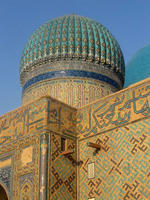You are in: Asia -> Kazakhstan -> Mausoleum of Khoja A... , and traditional search or Image Gallery will yield results of this site only
Mausoleum of Khoja Ahmed Yasawi
| Site number: | 1103 |
|
| Type of site: | Cultural | |
| Date: | 1389-1405 | |
| Date of Inscription: | 2003 | |
| Location: | Asia, Kazakhstan, South Kazakhstan Oblast, City of Turkestan | |
Up to 75 images are shown here. Click on each for more details or on Image Gallery for more images.
| Description: | The Mausoleum of Khoja Ahmed Yasawi, in the town of Yasi, now Turkestan, was built at the time of Timur (Tamerlane), from 1389 to 1405. In this partly unfinished building, Persian master builders experimented with architectural and structural solutions later used in the construction of Samarkand, the capital of the Timurid Empire. Today, it is one of the largest and best-preserved constructions of the Timurid period. --WHMNet paraphrase from the description at WHC Site, where additional information is available. For 360 degree imaging of this site, click here. | |
| Mazar of Khoja Ahmed Yasawi is an unfinished mausoleum in the city of Türkistan (or Hazrat-e Turkestan), south Kazakhstan. In 2002, it became the first Kazakh patrimony to be recognized by UNESCO as a World Heritage Site. The present structure was commissioned in 1389 by Timur to replace a smaller 12th-century mausoleum of a famous Sufi master, Khwaja Ahmad Yasavi (1103–66). Master builders from Persia, led by Khwaja Hosein Shirazi, erected a 39-meter-high rectangular building in ganch, i.e., fired brick mixed with mortar and clay, and crowned it with the largest dome ever built in Central Asia. This double dome, decorated with green and golden tiles, measures 18.2 metres in diameter and 28 metres in height. The building, one of the largest for its time, was left unfinished when Tamerlane died in 1405. As subsequent rulers paid little attention to it, the mausoleum has come down to us as one of the best preserved of all Timurid constructions. It contains some burials from the time of the Kazakh Khanate, notably the tomb of Ablai Khan. --Wikipedia. Text is available under the Creative Commons Attribution-ShareAlike License. For 360 degree imaging of this site, click here. | ||
| Source: | http://whc.unesco.org/en/list/1103 | |
| Reference: | 1. UNESCO World Heritage Center, Site Page. | |























